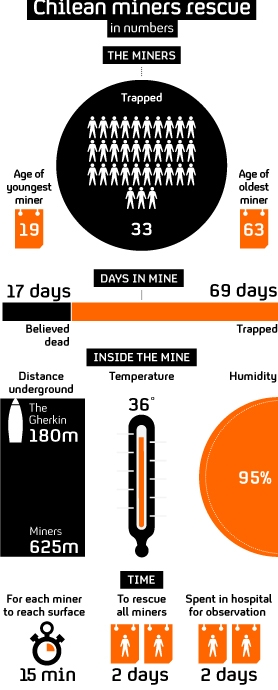Chile: 33 miners, 69 days, 625 metres underground
After almost 70 days trapped half a mile under ground the rescuers have begun the delicate rescue mission. Channel 4 News looks at the detail behind the “miracle” rescue.

From a story of a terrible tragedy the rescue of the Chilean miners has become a triumph of hope after the biggest ever rescue operation in mining history. Chile’s president proclaimed it a miracle.
It’s now 69 days since the miners were first trapped, 52 days before they made contact with the outside world, and just over a month since the rescue finally began.
The accident
The 33 miners were trapped half a mile underground when part of the San Jose mine collapsed in the Atacama desert on 5 August. A second collapse two days later hampered rescue efforts and blocked lower parts of the mine.
After seventeen days all the miners were discovered alive after rescuers found a note attached to probe sent down as an exploratory borehole.
Emergency supplies were sent down and communications set up. Meanwhile the miners’ families began camping on the surface.
With access to the tunnels blocked rescuers decided to drill a shaft down to the miners’ refuge and hoist them one by one to the surface.
The rescue
The 33 miners are trapped 625m below ground level.
The rescue team drilled three separate shafts down to the miners. Locally the pumps are nicknamed “The Tortoise”, “The Hare” and the “The Elephant”. “Plan B” – The Hare – broke through to the miners’ refuge last weekend.
Using the 12cm borehole, which reached the miners in August and had been delivering supplies, the Plan B hole was widened to 71cm – just wide enough to fit the escape pod. The internal dimensions are tiny: just 55cm wide.
The rescue cages were specially designed by navy engineers. Each capsule weighs just under 500kg, with communication links and three air tanks to allow the men to breathe for up to 90 minutes.
For the ascent the miners are kitted out with special clothing, a heart rate monitor and a helmet with a built-in communications system. Dark glasses are provided to protect the miners’ eyes and elastic bandages on the lower legs prevent problems blood circulation on the ascent.
Each man’s journey to the surface takes 15-20 minutes.